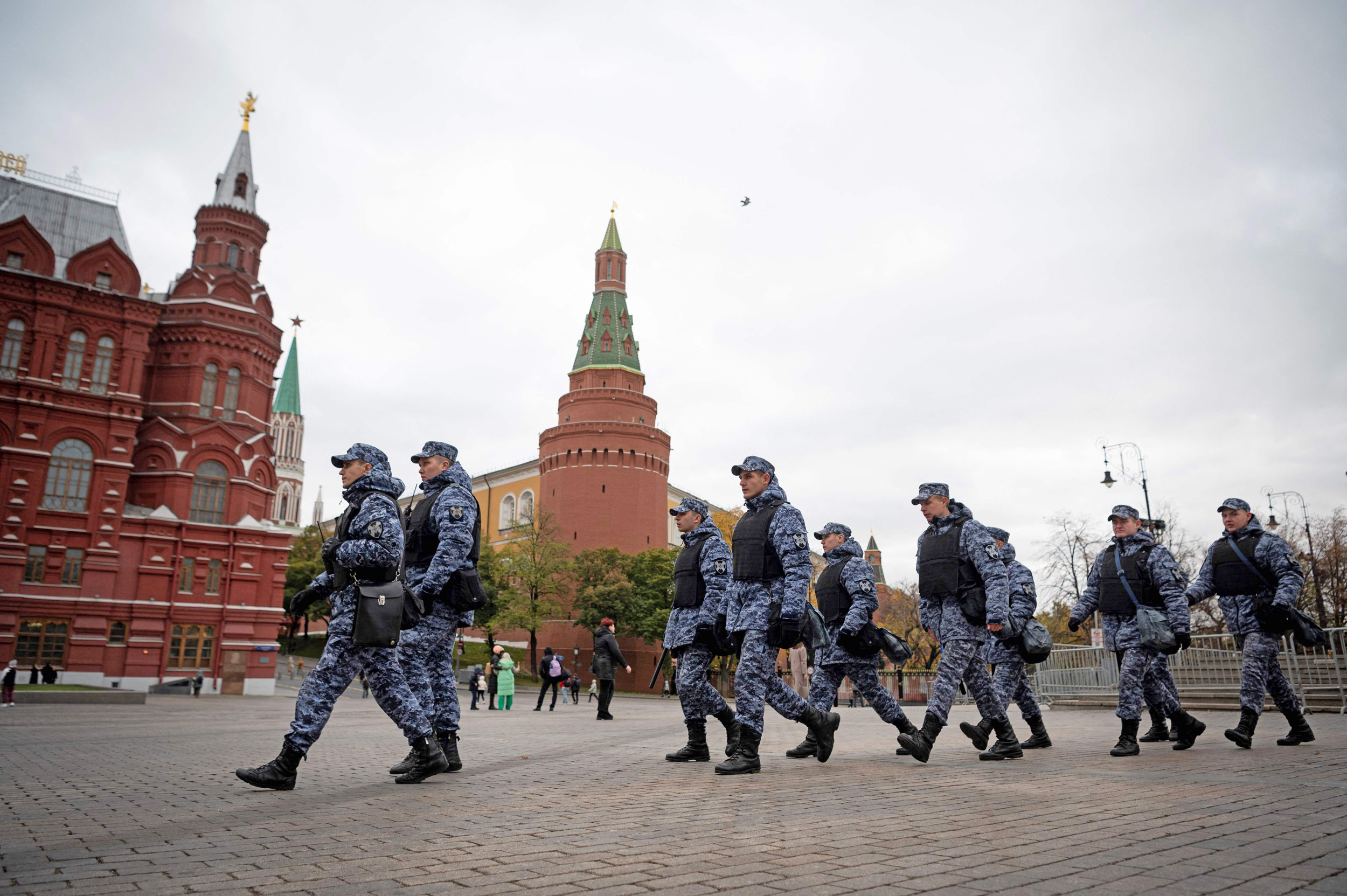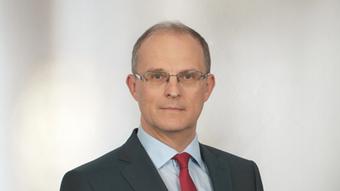Recent Posts – 5:27 PM 1/8/2022 – Link – January 8, 202
- Казахстан: арестован экс-глава КНБ и соратник НазарбаеваJanuary 8, 2022
- 4:43 PM 1/8/2022
- “Russia” – Google News: US open to limiting military exercises, missiles with Russia – Columbus Ledger-EnquirerJanuary 8, 2022
- “Russia Ukraine” – Google News: US offers carrots, threatens sticks with Russia over Ukraine – Las Vegas SunJanuary 8, 2022
- Взгляд: США выразили готовность договориться с Россией о неразмещении ракет на Украине January 8, 2022
- US offers carrots, threatens sticks with Russia over Ukraine – Minneapolis Star Tribune January 8, 2022
[the_ad_placement id=”manual-code”]
US, NATO rule out halt to expansion, reject Russian demands – Associated Press

- US, NATO rule out halt to expansion, reject Russian demands Associated Press
- U.S. plans to discuss missile deployments with Russia as part of effort to defuse Ukraine crisis The Washington Post
- NATO Vows United Response to Russian Aggression Against Ukraine The New York Times
- NATO rejects Russian demands to stop expansion | TheHill The Hill
- NATO Leaders Say They Won’t ‘Compromise Core Principles’ in Response to Putin’s Demands Newsweek
- View Full Coverage on Google News
All Articles Review | Selected Articles Review
Putin, Russia, Ukraine, Kazakhstan
Kazakhstan – Казахстан News Review Summary | RSS Page
Advice to the Russian Leadership
Russia News | Russia Video News | Russia, Ukraine, Nato | Putin and Putinism | Biden and Putin | Latest Video News from YouTube | Russia News – 2022 – Videos
Front Pages
The Powder Keg Of the Post-Soviet Central Asia And The Russia – Ukraine Conflict – 1.7.22
Advice to the Russian Leadership | Who really is Vladislav Klyushin? | Space Laser Weapons – January 1 – 5, 2022
Russia News Review – December 2021
Putin’s Grand Pressy 2021: Excerpts, photos, comments: “Би-би-си, пожалуйста, прошу Вас.”
[the_ad_placement id=”manual-code”]
Senior U.S. officials say the administration is open to discussions with Russia on curtailing possible future deployments of offensive missiles in Ukraine and putting limits on American and NATO military exercises in Eastern Europe if it’s willing to back off on Ukraine.
But, they also say that Russia will be hit hard with economic sanctions should it intervene in Ukraine. In addition to direct sanctions on Russian entities, those penalties could include significant restrictions on products exported from the U.S. to Russia and potentially foreign-made products subject to U.S. jurisdiction.
Russia could be added to the most restrictive group of countries for export control purposes, together with Cuba, Iran, North Korea and Syria, officials said.
The administration unveiled some details to its approach on Saturday as senior U.S. and Russian officials prepare to meet in Switzerland on Monday.
The officials said the U.S. is willing to discuss certain, limited aspects of its European security posture in those talks. But they stressed that any agreements would be contingent on Russia removing threats to Ukraine and that no decisions would be made without the consent of Ukraine or NATO.
The officials also said there is no chance the U.S. will reduce its military presence or arsenal in Eastern Europe as Russia has demanded.
While those comments, made to reporters on condition of anonymity in a White House-organized telephone conference call, were the first to suggest a willingness to compromise on issues tangential to Ukraine, they were accompanied by threats for Russian inaction.
In the event of a Russian invasion of Ukraine, “we – in coordination with our allies and partners – would immediately impose severe and overwhelming costs on Russia’s economy, including its financial system and sectors deemed critical to the Kremlin,” another official said.
In addition to sanctions on energy and consumer goods, the U.S. and its allies are considering bans on the export to Russia of advanced electronic components, software and related technology that uses American equipment.
That would mean that Russia’s ability to obtain integrated circuits, and products containing integrated circuits, would be severely restricted, because of the global dominance of U.S. software, technology and equipment in this sector. The impact could extend to aircraft avionics, machine tools, smartphones, game consoles, tablets and televisions.
Such sanctions could also target critical Russian industry, including its defense and civil aviation sectors, which would hit Russia’s high-tech ambitions, whether in artificial intelligence or quantum computing.
U.S. officials have been careful not to issue ultimatums to Russia, while at the same time demanding that threats to Ukraine cease. But they have also flatly rejected Russian demands that NATO will not further expand eastward and that the U.S. will remove troops and weapons from Eastern Europe.
Despite that stance, the U.S. and NATO have signaled a willingness to explore compromises on related issues.
“We think we can at least explore the possibility of making progress with the Russians,” one official said Saturday, ahead of Monday’s Strategic and Security Dialogue between the U.S. and Russia in Geneva. He added, though, that “there will be no firm commitments made in these talks.”
Monday’s meeting will be followed by discussions between Russia and NATO members on Wednesday and with a broader European audience on Thursday.
Президент Казахстана Токаев заявил, что события последних дней в Казахстане стали результатом нападения “бандитов и террористов”.
“Нам пришлось иметь дело с вооруженными, подготовленными бандитами. Как местными, так и иностранными. Именно с бандитами и террористами”, – сказал Токаев. Только на Алматы, по его словам, напали 20 тысяч “бандитов”.
Русская служба Би-би-си попросила экспертов дать оценку тому, кто может стоять за беспорядками на улицах Казахстана.
Что за “бандиты”?
Президент Токаев называет людей, вышедших на улицы Казахстана, “деструктивными силами”, заговорщиками и “международными террористическими бандами”.
Но опрошенные Би-би-си эксперты подвергают сомнению слова политика.
“Если внимательно присмотреться к тем событиям, которые власти прежде называли “террористическими актами”, можно увидеть гораздо более сложную картину, связанную с борьбой за власть внутри элит”, – говорит эксперт британского Королевского института международных отношений Кейт Маллинсон.
С оценкой Маллинсон согласен и британский бизнес-аналитик Бенджамин Годуин. Он отмечает, что изначально у протестующих в разных частях Казахстана были разные требования.
В Мангистауской области, где начались протесты, люди требовали снижения цен на газ. Жители нефтеносных районов страны требовали улучшения условий труда.
В некоторых других городах собравшиеся высказывались за изменение конституции Казахстана. А многие демонстранты просто выступали за необходимость перемен, у них не было четко сформулированных требований, потому что не было лидеров и какой-то организации.
Но к 5 января обстановка изменилась. На улицах появились группы вооруженных людей.
“К вечеру 5 января появились какие-то машины, из которых выходили люди с автоматами. Стало очевидно, что на улицах орудуют какие-то организованные группы, мародеры. Какие-то люди начали грабить банки. Это явно уже не протест. Демонстранты, которые раньше выходили на улицы с экономическими и политическими требованиями, просто остались дома. Они просто стали бояться выходить”, – отмечает Годуин.
“Вооруженные группировки, которые мы видели на улицах Алматы и других городов, напрямую не связаны с протестами. Они связаны с нынешней борьбой за власть между семьей Назарбаева и Токаевым”, – считает эксперт.
При этом и Годуин, и другие эксперты полагают, что озвученная Токаевым цифра в 20 тысяч “бандитов” – это, скорее всего, преувеличение.
Для сравнения: по оценкам ЦРУ, 20-30 тысяч человек – это численность всех боевиков “Исламского государства” на момент, когда группировка контролировала максимальное количество территорий в Сирии и Ираке в 2014 году.
Много ли экстремистов в Казахстане?
Опрошенные Би-би-си эксперты сходятся во мнении, что в Казахстане сейчас нет мощных центров религиозного экстремизма. Некоторые граждане страны в 2014-2018 годах вступали в ряды боевиков ИГ и отправлялись в Сирию, однако их число было невелико. Те, кто вернулся в Казахстан, попадали под суд, многие их них сейчас находятся в тюрьме.
“Роль радикальных исламистов крайне преувеличена. Казахстан сейчас не является рассадником доморощенных террористов”, – считает аналитик Маллинсон.
В первой половине 2010-х радикальные исламисты в Казахстане провели несколько вылазок. Но группы боевиков, вступивших в открытое противостояние с властями, были небольшими.
Но еще тогда эксперты отмечали, что казахские силы безопасности показали себя не совсем готовыми к эффективным и быстрым мерам по подавлению вооруженного сопротивления.
Профессор техасского университета A&M Эдвард Лемон отмечает, что на данный момент нет никаких свидетельств причастности каких-либо радикальных групп к погромам или штурму правительственных зданий: “Я сомневаюсь, что в Казахстане была сеть спящих ячеек, которая сейчас резко активизировалась и приняла участие в организации насилия. Возможно, что некоторые люди, вышедшие на улицы, разделяют радикальные взгляды. Но пока нет оснований полагать, что их действия контролируются террористическими организациями извне”.
Профессор факультета востоковедения и африканистики Университета Лондона Бхавна Даве отмечает, что спецслужбы Казахстана построили целую систему слежки за населением. Но тут же добавляет, что это не всегда означает, что они работают эффективно.
“Спецслужбы приглядывают за всеми. Кто надел платок, кто еще что-то сделал. Там, где люди собираются читать и изучать Коран на дому, обычно быстро появляются агенты спецслужб. Но внутри спецслужб есть свои группы влияния, своя борьба за власть. И совершая те или иные действия, силовики могут иногда преследовать личные или групповые, но не государственные интересы”, – говорит Даве.
Кто может стоять за вооруженными погромщиками?
Эксперты разделились в оценке того, кто может стоят за вооруженными группами.
“Эти люди явно представляют собой значительную и хорошо подготовленную силу, которая, по-видимому, была развернута для того, чтобы дискредитировать Токаева и заставить его уйти в отставку”, – считает Годуин.
Профессор Национального университета обороны в Вашингтоне Эрика Марат допускает, что нападавшие на магазины и здания могли действовать по своей инициативе: “Я не отвергаю версию о том, что некоторые погромщики были наняты представителями властей. Но в то же время я допускаю, что это могло быть просто развитие протестных настроений. Очень важно отметить, что проявления насилия и агрессии начались именно после того, как власти дали полиции команду применять слезоточивый газ, светошумовые гранаты и прочие силовые методы разгона протестующих”.
По словам эксперта, жесткие действия полиции против мирных демонстрантов нередко приводят к мобилизации и радикализации протеста. Люди воспринимают насилие в отношении себя как незаконное действие со стороны властей, у них появляется гнев.
Более радикальные представители толпы (как правило, молодые мужчины) начинают проявлять эту злость, атакуя силовиков или нападая на государственные здания как на символ власти. Примеры такого поведения можно увидеть во время протестов по всему миру.
“Но обратите внимание, что в городах, где протесты были более организованными, погромов практически не было. Там, где во главе протестующих встали профсоюзы (например, нефтяники) или НКО, ситуация осталась под контролем. Протест мутировал в радикальные формы там, где не было лидеров – и там, где государство чрезмерно использовало силу”, – отмечает Марат.
Профессор Даве не исключает, что погромы, произошедшие 5-6 января, могли быть спровоцированы спецслужбами: “Захват аэропорта, нападения на здания, в том числе на военные объекты, грабежи – все это не могло произойти в таких масштабах без участия спецслужб. Я думаю, что кто-то намеренно внедрил своих агентов в ряды протестующих. Некоторые представители политических элит хотели бы дестабилизировать ситуацию, подорвать власть Токаева и укрепить свои позиции”.
Эксперт отмечает, что в Казахстане существует целый ряд бизнес-групп, кланов и лоббистов с определенными экономическими интересами.
“Это очень сложная многовекторная система. Назарбаев как-то умудрялся держать ее под контролем. Внутри системы разные силы конкурировали, но на его позиции никто не покушался. Сейчас эта система разваливается, а какого-то очевидного преемника нет”, – говорит Даве.
“We’re monitoring reports of protests in Kazakhstan. We support calls for calm, for protesters to express themselves peacefully and for authorities to exercise restraint,” Psaki told reporters during her regular briefing.
“There are some crazy Russian claims about the US being behind this. Let me just use this opportunity to convey that as absolutely false, and clearly a part of the standard Russian disinformation playbook.”
Hours earlier, Kazakhstan President Kassym-Jomart Tokayev declared a state of emergency as government buildings were attacked across the city of Almaty. Soon after, the government of Prime Minister Askar Mamin announced its resignation, but Tokayev said the ministers would remain in their roles until a new cabinet is formed, making it uncertain whether the resignation will have significant effect.
The violent protests were sparked by a significant increase in fuel prices. The price of liquefied gas, mainly used for heating and cooking, doubled to 120 tenge ($0.27) per liter. In Kazakhstan, the minimum wage is 42,500 tenge ($98) per month.
The unrest comes amid growing tensions between Russia and another neighbor, Ukraine.
Throughout 2021, Russian President Vladimir Putin pressed NATO and the US to promise not to let Ukraine join the trans-Atlantic alliance — while simultaneously increasing Russia’s military presence along its western border.
Putin has repeatedly pushed for the security guarantees, telling President Biden as recently as last month that “Russia needs legally binding agreements” on the requests.
In turn, the US has warned Russia against invading Ukraine — as many fear a reprise of 2014, when Russia invaded and annexed the province of Crimea.
During a Dec. 30 call between Biden and Putin, the American president “urged Russia to de-escalate tensions with Ukraine” and warned that “the United States and its allies and partners will respond decisively if Russia further invades Ukraine,” according to Psaki.
Starting Jan. 10, Russia and the US will hold security talks in Geneva to discuss Moscow’s request. NATO will then meet with Russia two days later, followed by another meeting with other European allies on Jan. 13.
“Russia is very familiar with our positions, which are grounded in the fundamental principles of European security they once agreed to,” Psaki said Wednesday, “including that borders cannot be redrawn by force, and countries have the sovereign right to determine with whom they associate.”
“We don’t know what next week’s conversations will bring,” she added. “But our approach to the discussions will be pragmatic, results-oriented, and we believe there are areas we can make progress on with Moscow, make progress on if they come to the table ready to do that. And obviously that’s the nature of diplomacy.”
With Post wires
Although the issue will soon return to the agenda, it has lost urgency in light of the unrest unfolding in Kazakhstan, Russia’s large Central Asian neighbor.
A Russian military operation on Ukrainian territory has now become less likely. There are two reasons for this. One is that a Russian military intervention could lead to domestic instability inside Russia similar to the unrest unfolding in Kazakhstan.
The other stems from the fact that Russia must now dedicate much more attention to its southern neighbor, Kazakhstan.
A seemingly stable Kazakhstan
Kazakhstan’s nationwide protests came as a surprise; the fierce clashes and countless fatalities will have rattled Moscow. Until now, Kazakhstan was considered a largely stable country with a dependable government.
Increase Volume↑
Decrease Volume↓
Seek Forward→
Seek Backward←
Captions On/Offc
Fullscreen/Exit Fullscreenf
Mute/Unmutem
Seek %0-9
‘2,000 people arrested in Almaty’
Belarus, too, was regarded as a stable country — until the 2020 revolution and subsequent repression. That two post-Soviet states with similarly authoritarian government structures could experience such instability suggests that Russia should at all costs avoid anything that could spark such developments at home.
Minsk, Almaty, then Moscow?
A large Russian military operation against Ukraine, without a clear objective and scores of dead soldiers, could certainly spark mass unrest within Russia. Especially if the US and EU impose far-reaching sanctions — as has been threatened — leading to a sharp rise in the already horrendously high consumer prices and possible supply shortages.
This scenario looks even more menacing against the backdrop of spiking omicron cases and Russia’s seriously overwhelmed health care system.
Domestic fallout
The fact that thousands of frustrated Kazakhs are now venting their anger should be a warning to the Kremlin. It should compel Russia to consider the domestic implications of a threatened or alleged military operation with which it is currently trying to intimidate the US and NATO.
So far, Russia only seems to have weighed up what impact such a move would have on its foreign policy and trade. Given the crisis in Kazakhstan, however, Russia may now also have growing doubts over whether its population would back it.
It will most likely make Russia even less inclined to wage an actual military campaign, rather than a mere propaganda campaign, against Ukraine.
The Kremlin must devote more energy to assisting Kazakhstan. It is, after all, one of Russia’s few real allies, and an integration partner in the post-Soviet sphere and on the international stage.
-
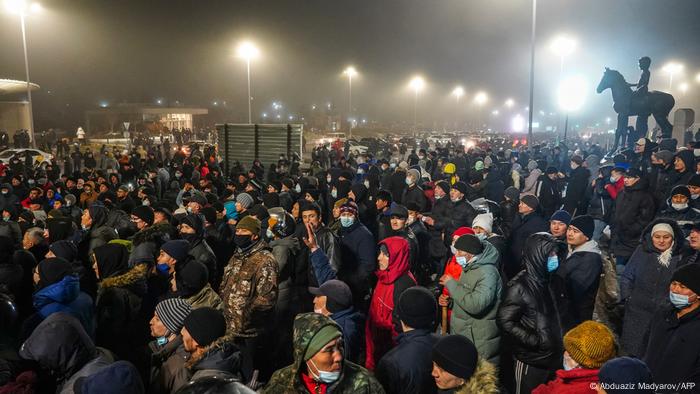
In pictures: Kazakhstan protests escalate
Mass protests hit streets
Protests were first triggered by a dramatic rise in the price of fuel. Within a matter of days, the unrest spread throughout the oil-and-gas-rich former Soviet republic of 18 million, morphing into a broad, anti-government protest wave.
-
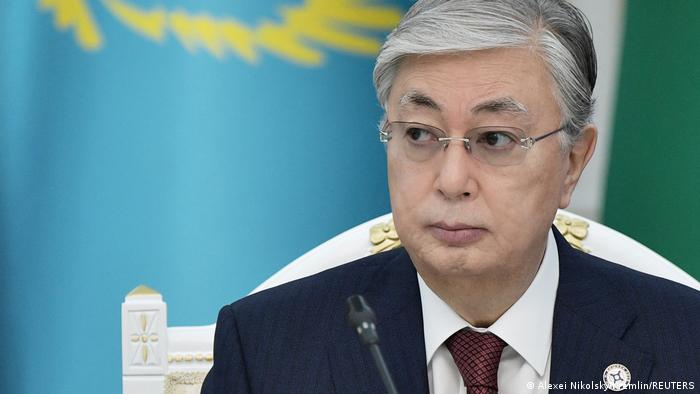
In pictures: Kazakhstan protests escalate
Leadership under pressure
To placate protesters, fuel prices were cut. President Kassym-Jomart Tokayev (pictured above in 2019) on Wednesday dismissed the government. Countrywide protests, however, continue unabated.
-
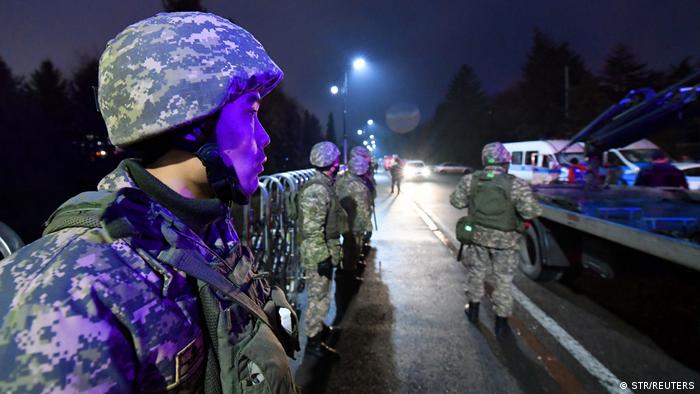
In pictures: Kazakhstan protests escalate
Military deployed to Almaty
President Tokayev has announced a state of emergency, leading to nationwide nighttime curfews, limits to where people may move and a ban on gatherings. Tokayev has also called on the Collective Security Treaty Organization (CSTO), a Russia-led military alliance, to provide help.
-
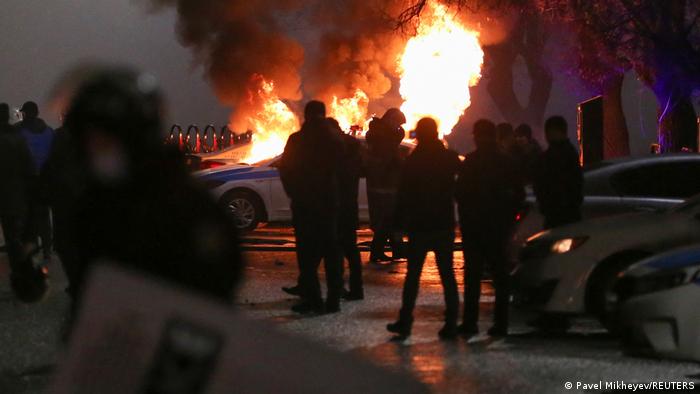
In pictures: Kazakhstan protests escalate
Pent-up anger, large-scale destruction
On Wednesday, thousands of people stormed the city hall and other government buildings in Almaty, Kazakhstan’s most populous city and commercial center. Several government buildings reportedly went up in flames. Protesters also briefly took control of Almaty airport.
-
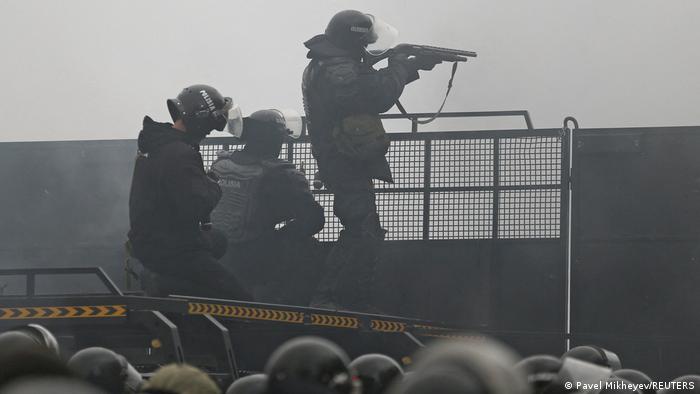
In pictures: Kazakhstan protests escalate
Casualties and fatalities
According to government reports, at least 18 security offices have been killed. Authorities also say “dozens of attackers” have been “eliminated,” meaning scores of civilians have been killed as well. Over 1,000 people have reportedly been injured. Almost 400 were sent to hospitals around the country for treatment, according to Deputy Health Minister Azhar Guiniyat.
-
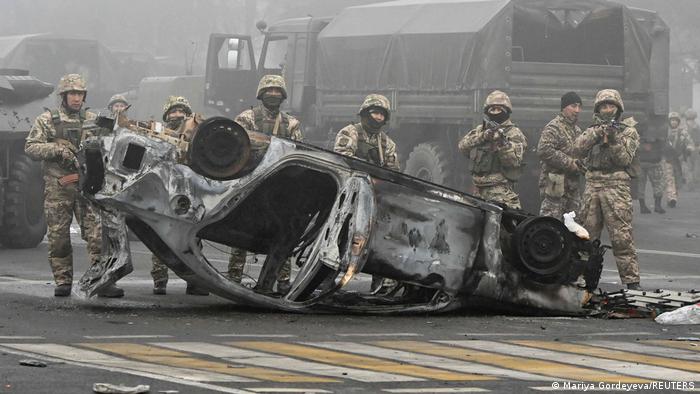
In pictures: Kazakhstan protests escalate
Rare unrest
Large-scale protests are unusual in Kazakhstan, which remains under authoritarian rule. President Tokayev, who succeeded long-time ruler Nursultan Nazarbayev in 2019, faces the gravest crisis of his tenure. The 81-year-old Nazarbayev is said to retain considerable influence in the country, and is a close ally of Russian President Vladimir Putin.
-
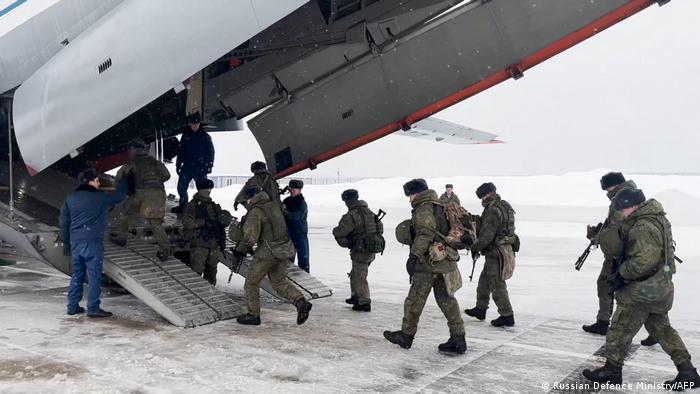
In pictures: Kazakhstan protests escalate
Russian troops dispatched
Russia has already sent paratroopers (pictured here departing from near Moscow) as part of a wider CSTO peacekeeping mission. Other CSTO member states include Kazakhstan, Armenia, Belarus, Kyrgyzstan and Tajikistan. Authorities have said foreign troops will help protect key state and military sites.
Author: Philipp Böll
Russia to focus on Kazakhstan
Kazakhstan finds itself undergoing major changes. Moscow must now dedicate considerable attention, effort and time to influencing this difficult and complex political process — especially now that Russia has dispatched troops to Kazakhstan at the request of President Kassym-Jomart Tokayev for an indefinite period.
The move could have unpredictable consequences. Several days ago, nobody would have expected this development.
Kremlin will avoid fighting on two fronts
If Russia gives in to the illusory idea of “taking back” Ukraine, it will risk “losing” Kazakhstan. Doing so would also burden the Russian military and populace with a “two-front campaign.”
One would expect the Russian leadership to be sufficiently pragmatic and show enough political survival instinct to throw out such an idea.
Even so, Moscow may continue conjuring up the specter of a major war against Ukraine in the hopes of securing big concessions in upcoming negations with the West.
This commentary was originally written in German
